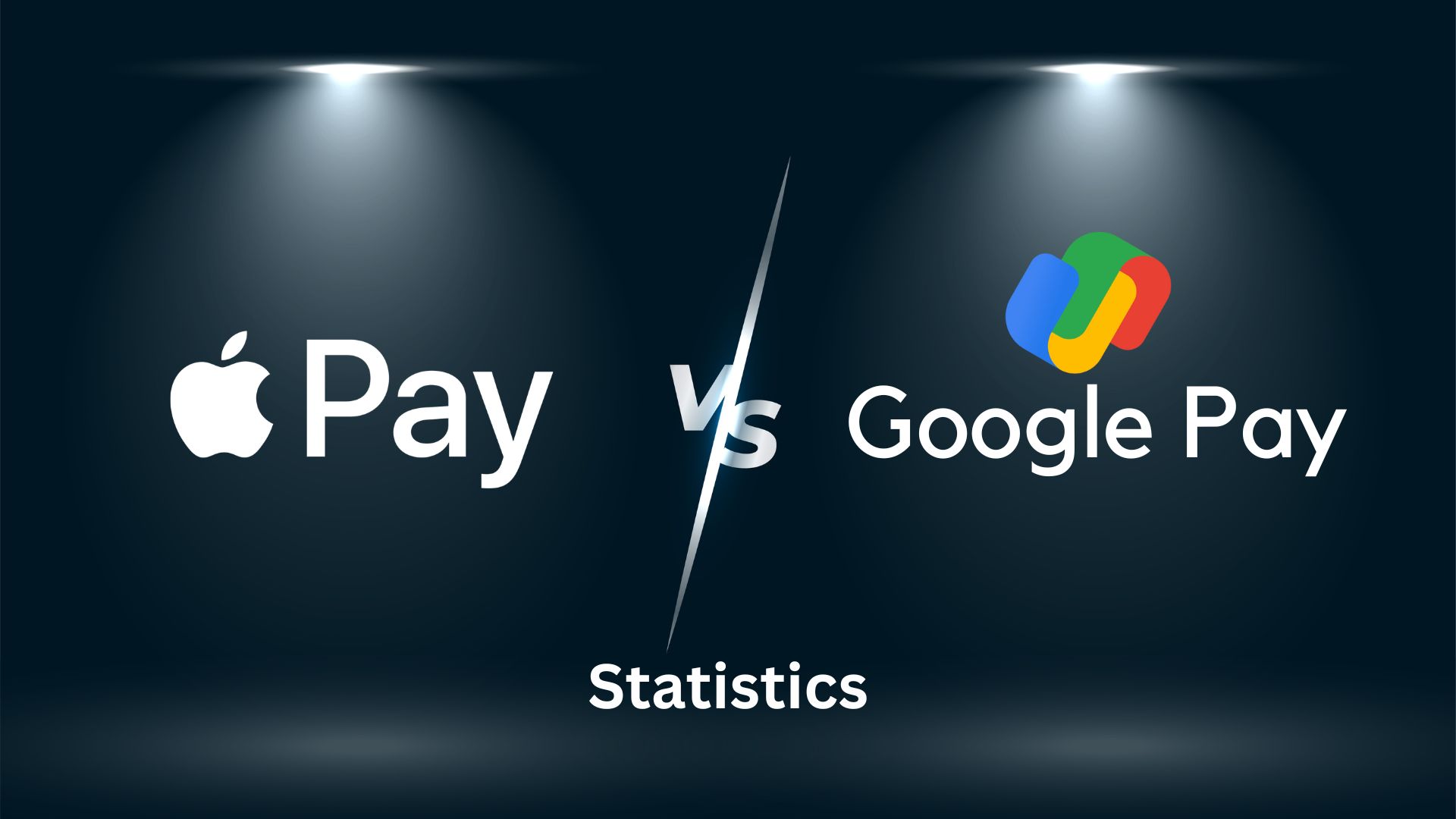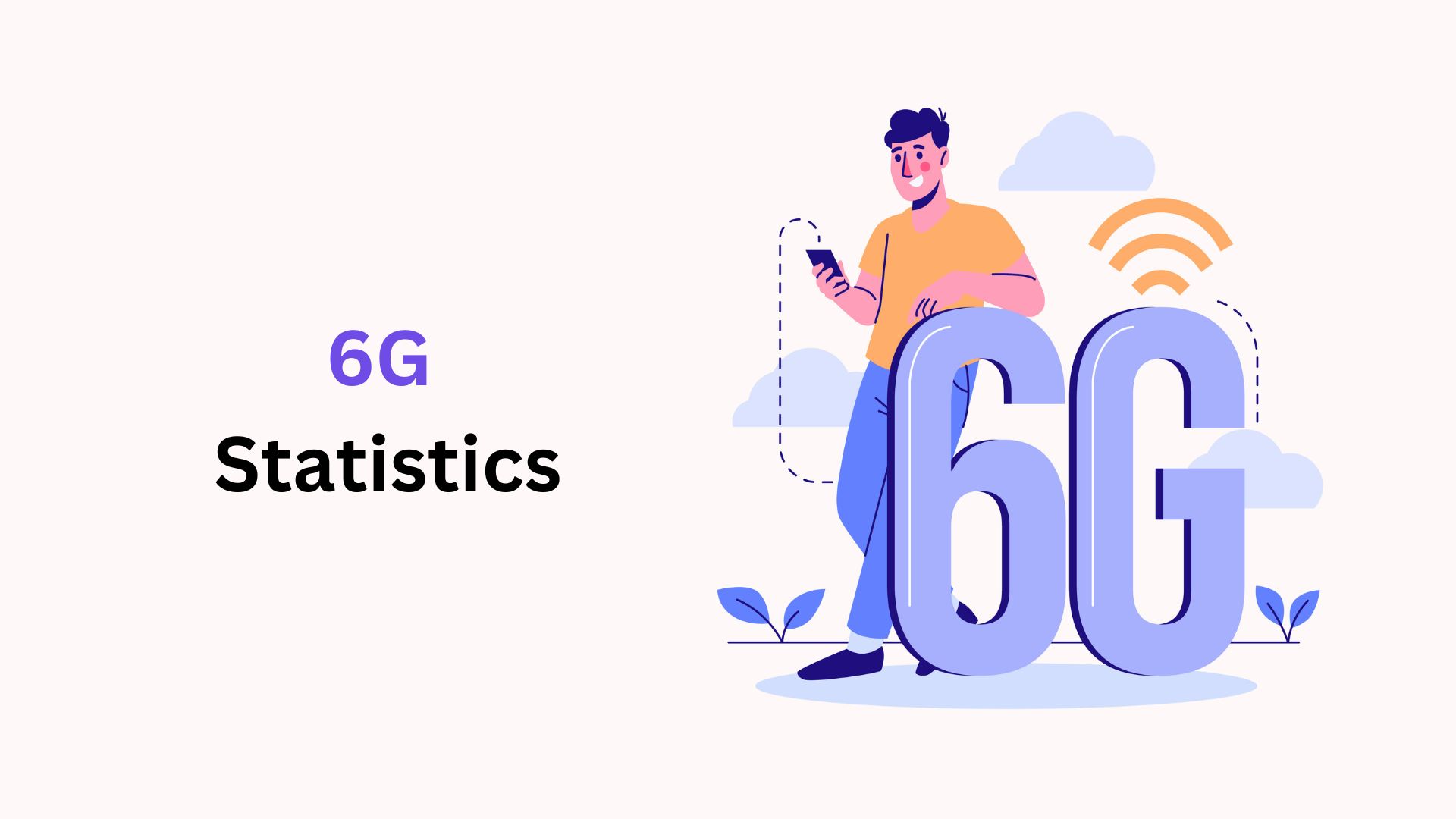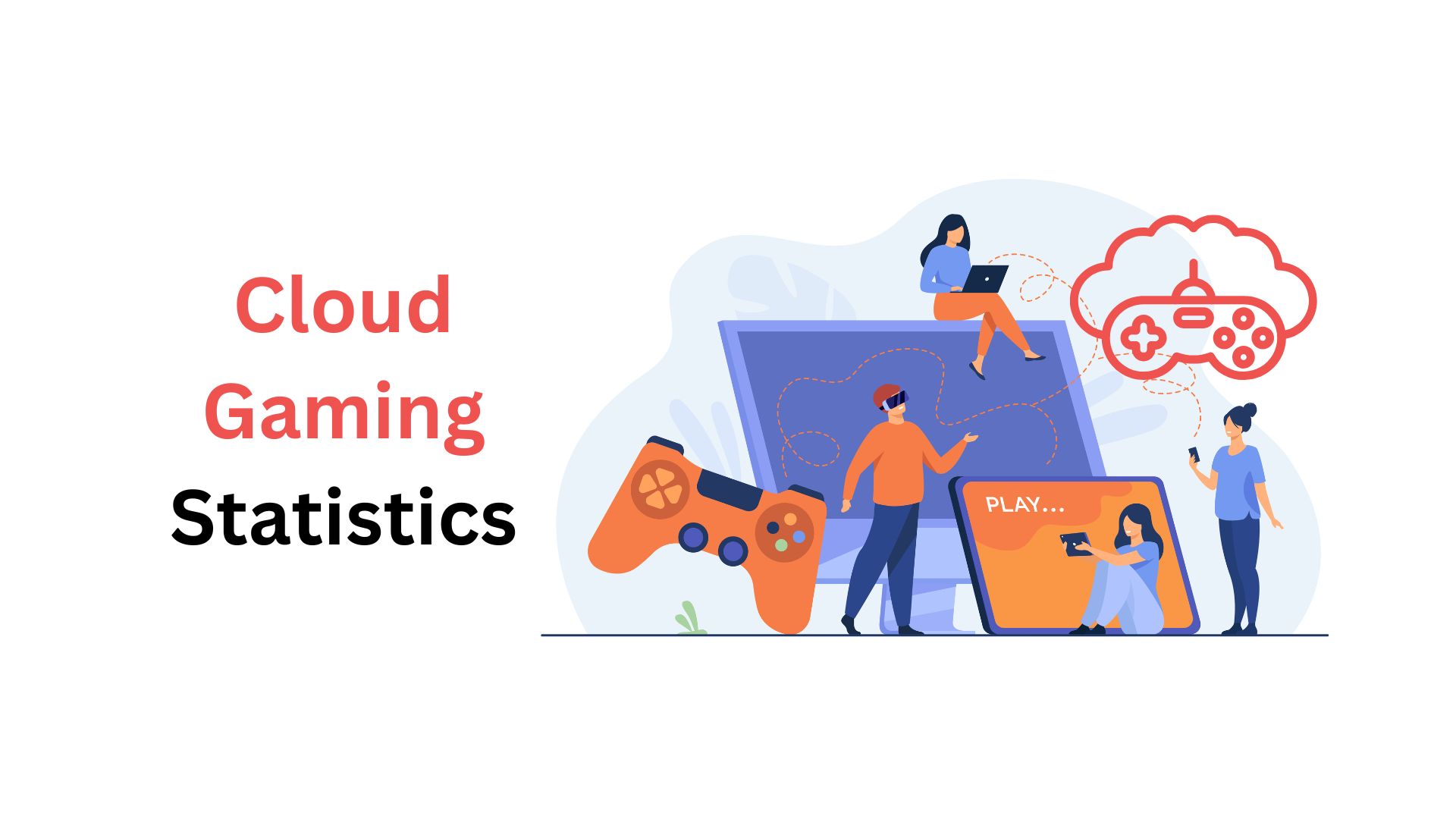AI Companions Statistics By Usage, Market Size, Apps and Facts (2025)
Updated · Nov 27, 2025

Table of Contents
- Introduction
- Editor’s Choice
- General AI Companion Statistics
- AI Companion Market Statistics
- AI Companion App Market Size
- AI Companion Apps Release Statistics
- Average Daily Time Spent on Top AI Companion Apps
- Top Countries Downloading AI Companion Apps
- AI Companion Robot Market Size
- AI Companion Usage Statistics
- Teen Trust and Satisfaction with AI Companions
- Real-Life Skills Practised Through AI Companions
- Teen Interaction and Comfort Levels with AI Companions
- Conclusion
Introduction
AI companions Statistics: In recent years, several AI companions, comprising apps, have started using artificial intelligence to interact with people in a human-like way. They can chat, give emotional support, and provide entertainment. With the help of machine learning and NLP, these apps learn what users like and offer more personalised and meaningful experiences.
Thanks to rapid progress in AI technology, the market has expanded quickly, and these apps are becoming more intelligent, helpful, and engaging than ever before. Demand is rising in healthcare, mental wellness, and entertainment, and as phones and smart devices spread, AI companions are becoming a natural part of everyday life.
Editor’s Choice
- Adoption of AI companions is rising across multiple sectors, with 48% of users relying on them for mental health support and 36% using them for learning.
- A TechCrunch study in 2025 found that almost 72% of United States teens have tried an AI companion.
- According to Market.us, the global AI Companion Apps market is estimated to reach USD 15 billion by 2025.
- AI companion app releases grew rapidly, rising from 16 apps in 2022 to 128 apps in July 2025.
- Daily usage across AI companion apps: Character leads at 92 minutes, followed by PolyBUZZ at 69 minutes.
- From 2024 to 2025, the United States leads global AI companion app downloads with 16%.
- By 2025, the global market for AI companion robots is projected to reach USD 13.4 billion.
- Entertainment is the top reason for using AI companions at 30%, followed by curiosity about the technology at 28% and seeking advice at 18%.
- 50% of teens do not trust information or advice from AI companions, 27% somewhat trust them, and only 23% fully trust them.
- As of 2025, approximately 80% of teens spend more time with friends than with AI companions.
General AI Companion Statistics
- According to Grand View Research, in October 2024, Zoom introduced AI Companion 2.0, a text-based assistant that boosts productivity.
- Amazon built its AI companion features through Alexa, while Google created Google Assistant to help users with tasks and information.
- Troodi, an AI mental health companion for children, was launched by Troomi in March 2025.
- Many businesses now use AI companions to cut costs, better engage customers, and provide continuous support.
- A TechCrunch study in 2025 found that almost 72% of United States teens have tried an AI companion.
- Moreover, 52% use them regularly, 13% chat daily, 21% weekly, while 31% of boys and 25% of girls never use one.
- Snapchat’s My AI has 150 million users, Replika has about 25 million, and Xiaoice remains the largest with 660 million users.
- Accoding to Techrunch, 72% of US teens have used AI companions at least once, indicating broad exposure to conversational AI among individuals aged 13 to 17.
- The analysis defines AI companions as chatbots designed for personal conversations, including platforms such as Character.AI and Replika, as well as general chatbots like ChatGPT and Claude when used for personal interaction.
- The findings reveal that 52% of teens are regular users of AI companions, with 13% interacting daily and 21% engaging a few times each week, showing steady usage across the segment.
- Boys show a slightly higher rate of non-adoption, as 31% report never using an AI companion compared with 25% of girls, among the one in four teens who have never tried these tools.
- The study was conducted during April and May 2025 with a representative sample of 1,060 teens, reflecting an evidence-based view of teen engagement with conversational AI.
- Concerns have emerged about the potential impact of AI on teen well being, including reports of harmful interactions and legal actions linked to AI platforms such as Character.AI.
- The study provides early insight into how teens use AI companions for virtual friendship, emotional support, therapy like interactions, and role playing, highlighting a wide range of social and emotional applications.
- Nearly 46% of teens view AI companions as tools or programs, while 33% use them for social interaction and relationship like conversations.
- Usage motivations include entertainment at 30%, curiosity about AI technology at 28%, seeking advice at 18%, and valuing constant availability at 17%, showing diverse engagement drivers.
- Trust remains limited, as 50% of teens report not trusting information provided by AI companions. Older teens show lower trust levels, with 20% expressing trust compared with 27% of younger teens aged 13 to 14.
- About 33% of teens feel AI conversations are more satisfying than those with real friends, although 67% prefer real-life social interactions.
- AI companions support skill development, as 39% of teens apply skills practiced with AI to real situations, especially in social skills, conversation starters at 18%, giving advice at 14%, and expressing emotions at 13%.
- The findings indicate that real-life relationships remain dominant, as 80% of AI companion users say they spend more time with friends than with chatbots, while only 6% report the opposite.
AI Companion Market Statistics
- According to Grand View Research, the global AI Companion market size accounted for USD 28.19 billion in 2024.
- On the other hand, the Business Research Insights report shows that the market is expected to reach USD 366.7 billion in 2025, rising to USD 501 billion in 2026 and USD 972.1 billion by 2035 with a 36.6% CAGR (2026 to 2035).
- Adoption of AI companions is rising across multiple sectors, with 48% of users relying on them for mental health support and 36% using them for learning.
- However, growth is slowed by concerns, as 42% worry about data security and 28% fear becoming dependent on AI.
- Personalisation has improved through generative AI, leading 55% of users to prefer emotionally aware interactions, while 33% engage with their companions daily.
- Regionally, North America holds 41% of the market, followed by Asia-Pacific at 32%.
- The top five companies control 46% of the market, supported by 29% investment in R&D and 21% in AI voice technology.
- Social companionship leads with 39%, ahead of healthcare at 27% and education at 22%, while 37% of companies upgraded emotional intelligence and 31% expanded multilingual, cross-platform services.
AI Companion App Market Size

(Source: market.us)
- The Global AI Companion App Market is expected to reach USD 290.8 Billion by 2034, rising from USD 10.8 Billion in 2024, supported by a 39% CAGR from 2025 to 2034.
- North America is estimated to maintain a strong lead in 2024 with a 36% share, generating USD 3.88 Billion in revenue due to high adoption across the U.S.
- Leading AI companion platforms reported strong engagement in 2024, as ChatGPT crossed 160 million downloads and generated nearly USD 270 million in revenue, while Remini recorded 450 million downloads and USD 200 million in in-app purchase revenue.
- Younger users aged 18 to 35 accounted for more than 70% of total engagement across major AI companion apps such as Character AI and Talkie AI.
- Character AI reached 22 million monthly active users in August 2024, and the combined user base for the top six AI companion platforms is estimated at 52 million, reflecting high global demand.
- AI and chatbot app downloads increased by more than 14x year over year in 2023, reaching nearly 600 million, and downloads in the first eight months of 2024 surpassed 630 million, indicating rapid adoption.
- Global in-app purchase revenue for AI companion applications climbed to nearly USD 580 million, exceeding the previous year’s total and signaling strong monetization potential.
- The text-based AI companion category is expected to dominate in 2024 with a 45% share, as users prefer simple and direct interactions.
- The mental health support application segment is projected to capture 40% of the market in 2024, driven by rising demand for emotional assistance and well-being tools.
- Female AI companions are anticipated to hold around 60% of the overall market share, indicating higher user preference for supportive and empathetic virtual personas.
- North America is forecasted to retain its leadership with a 36% share in 2024 due to growing acceptance of digital companionship and mental health solutions.
- Market expansion is expected to accelerate due to the 39% CAGR, supported by technological improvements, rising personalization needs, and increased awareness of AI-based mental health support.
AI Companion Apps Release Statistics

(Source: s.yimg.com)
- Demand for AI companion applications outside leading platforms has continued to rise, supported by expanding user interest in personalized conversational agents.
- A total of 337 active and revenue-generating AI companion apps are currently available worldwide, and 128 of these were introduced in 2025, according to new data shared with TechCrunch by Appfigures.
- This segment of the mobile AI market generated USD 82 million in the first half of 2025 and is expected to surpass USD 120 million by the end of the year.
- AI companion apps differ from general chatbots by simulating humanlike interactions through custom characters that include friends, partners, and fantasy-based personas created either by developers or users.
- Major apps in this category include Replika, Character.AI, PolyBuzz, Chai, and several others.
- As of July 2025, AI companion applications across the Apple App Store and Google Play recorded 220 million cumulative global downloads.
- Downloads increased 88% year-over-year in the first half of 2025, reaching 60 million during this period.
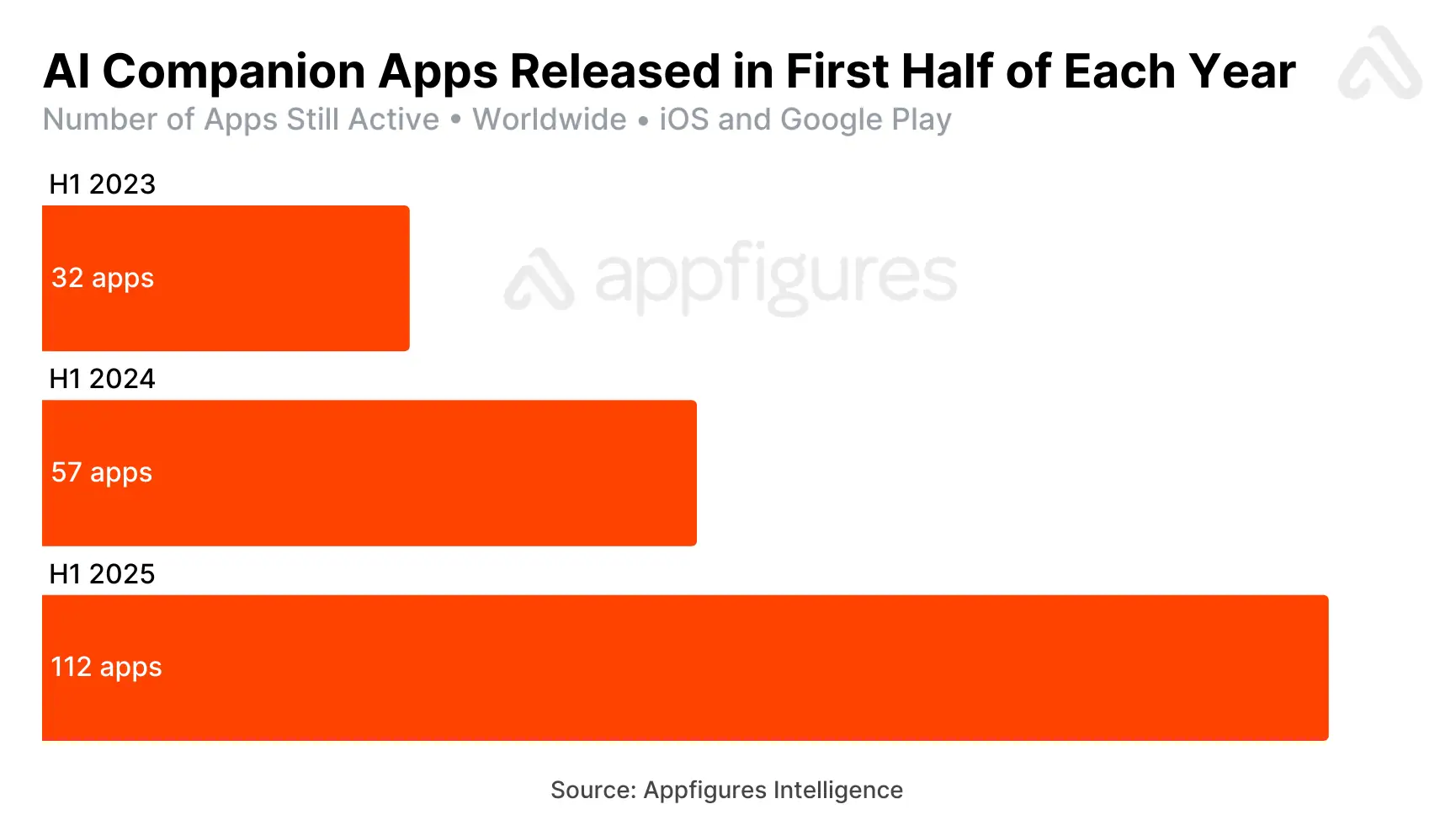
- Appfigures reported that global consumer spending on these applications reached USD 221 million as of July 2025.
- Revenue generated in the first half of 2025 was 64% higher compared to the same period in 2024, indicating stronger monetization.
- The top 10% of AI companion apps captured 89% of total category revenue, highlighting concentrated earning power among a small group of developers.
- Around 10% of these apps, equal to 33 platforms, surpassed USD 1 million in lifetime consumer spending.
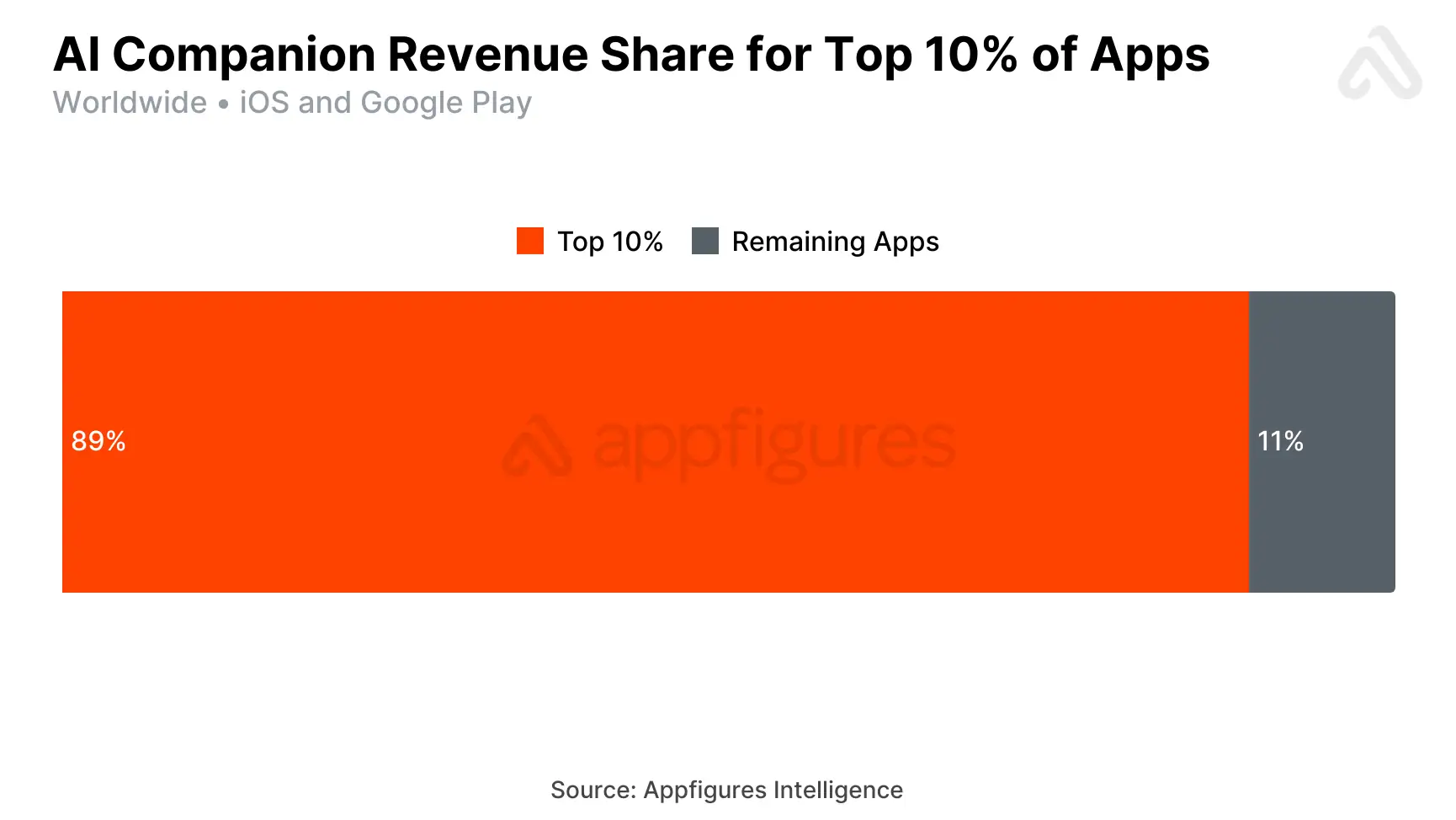
- Revenue per download increased from USD 0.52 in 2024 to USD 1.18 in 2025, reflecting stronger consumer willingness to pay, equal to a gain of USD 0.66 per user.
Average Daily Time Spent on Top AI Companion Apps
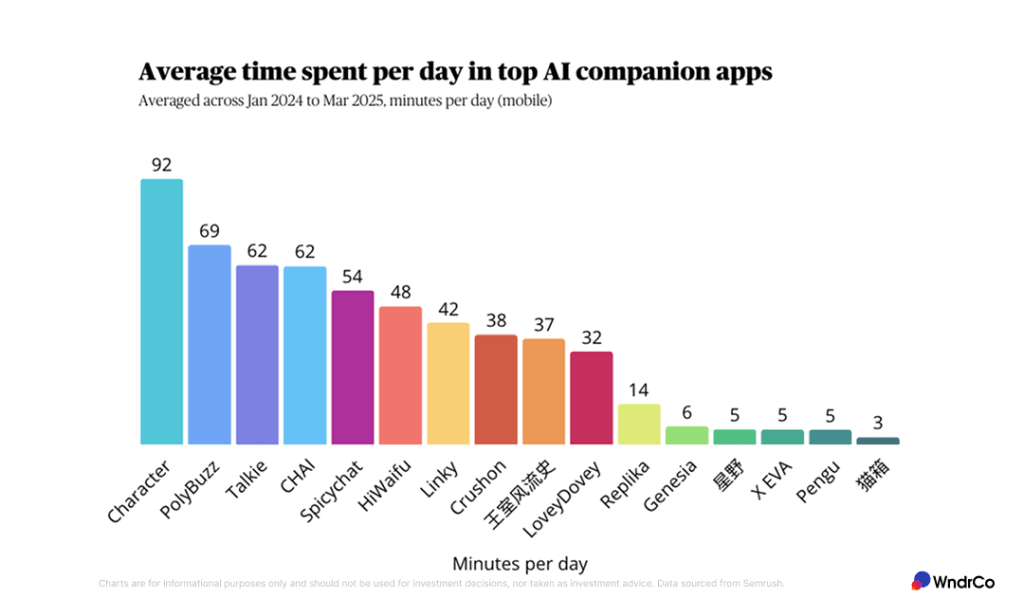
(Source: vccafe.com)
Top Countries Downloading AI Companion Apps
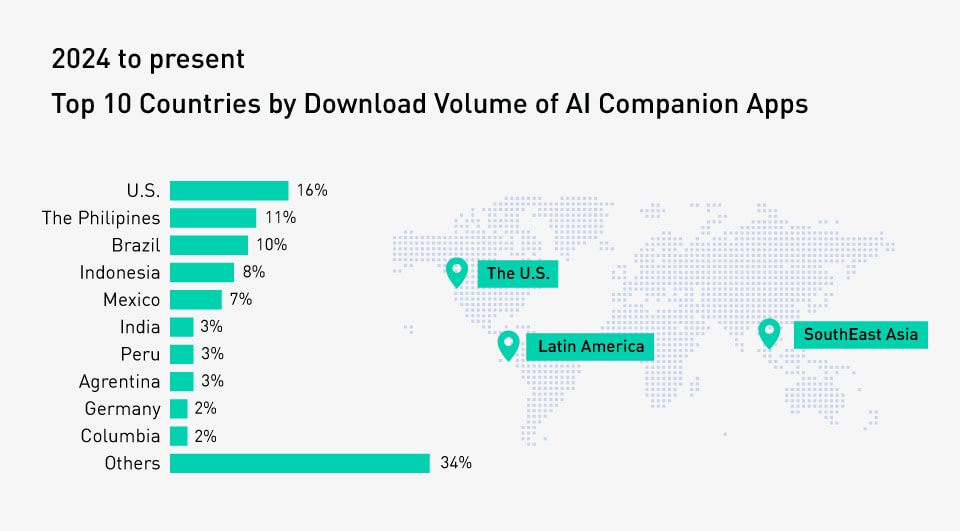
(Source: assets-official.mintegral.com)
- The United States leads global AI companion app downloads with 16%, followed by the Philippines at 11%, Brazil at 10%, Indonesia at 8%, and Mexico at 7%.
- Meanwhile, India, Peru, and Argentina each hold 3%, and Germany and Colombia each contribute 2%.
- All remaining countries together make up the largest share at 34%.
AI Companion Robot Market Size
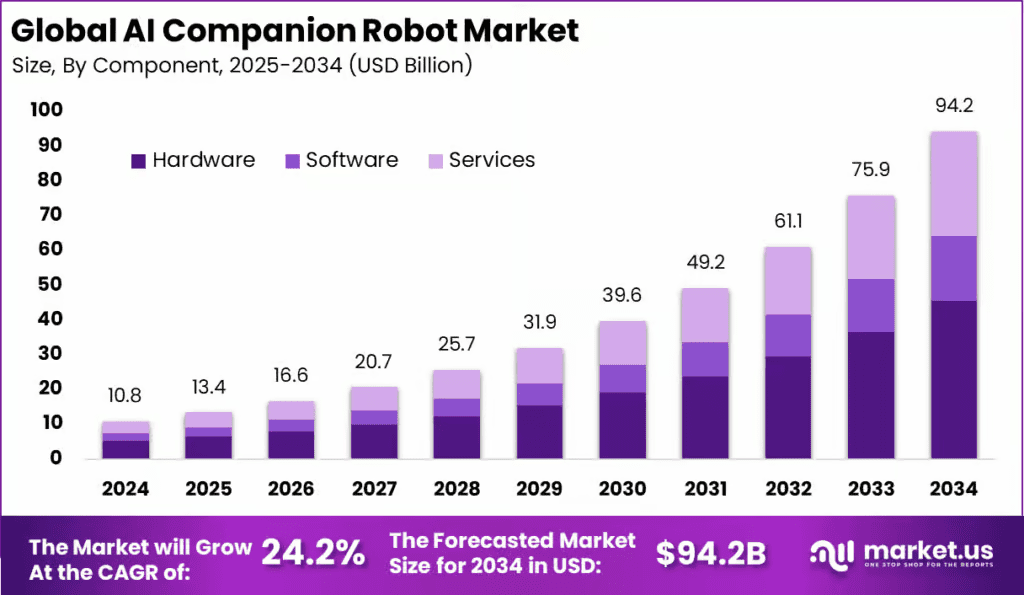
(Source: market.us)
- The Global AI Companion Robot Market is projected to reach USD 94.2 Billion by 2034, rising from USD 10.8 Billion in 2024 at a 24.2% CAGR during 2025 to 2034.
- North America maintained a dominant position in 2024 with a 35.6% share and generated USD 3.8 Billion, supported by strong healthcare innovation, an aging population, and steady adoption of consumer robotics.
- The U.S. contributed USD 3.66 Billion in 2024 and is expected to expand at a 23.1% CAGR, driven by rising demand for AI-enabled home care and personal assistance solutions.
- Hardware accounted for the largest contribution at 48.2%, as improvements in sensors, actuators, and humanoid engineering strengthened real-world robot interaction.
- Mobile robots held a 56.5% share within mobility types, as movement capabilities remained crucial for companionship, caregiving, and household activities.
- Multimodal interaction led with 38.7%, combining voice, touch, gesture, and emotion recognition to enhance user connection and engagement.
- The Elderly age group represented 44.1% of the user base, reflecting growing dependence on AI companion robots for emotional comfort and routine daily support.
- Elderly Care and Assisted Living captured 29.4% of total applications due to increasing use in loneliness reduction, medication reminders, and cognitive assistance.
- Residential settings accounted for 52.3%, showing strong consumer acceptance of AI companion robots in personal and family environments.
AI Companion Usage Statistics
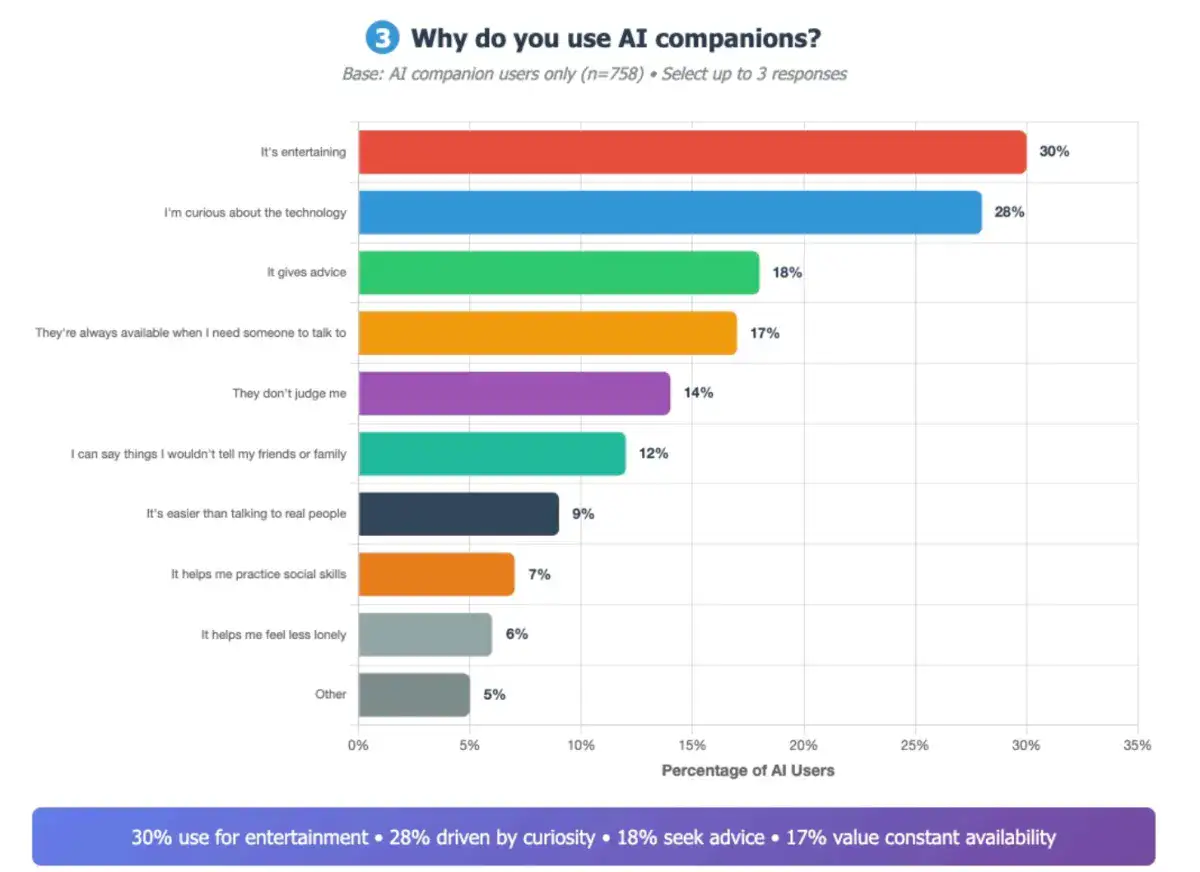
(Source: techcrunch.com)
Teen Trust and Satisfaction with AI Companions

(Source: techcrunch.com)
- 50% of teens do not trust information or advice from AI companions, 27% somewhat trust them, and only 23% fully trust them.
- When rating their conversations, 67% of teens say the chats are less satisfying, and 21% feel the experience is about the same as expected.
- Only 10% find AI companion conversations more satisfying than expected.
- Additionally, 2% of respondents did not respond to the satisfaction question.
Real-Life Skills Practised Through AI Companions

(Source: Techcrunch)
- The findings show that 39% of users have applied social skills practiced with AI companions in real situations, indicating meaningful crossover between digital and offline interactions.
- A total of 18% report using AI companions to improve conversation starters, which highlights their role in helping users initiate dialogue.
- Around 14% have used advice-giving skills developed through AI interactions, suggesting confidence building in guiding others.
- Expressing emotions practiced with AI companions has been used by 13% of users in real life, reflecting support for emotional articulation.
- Skills related to apologizing or resolving conflicts have been applied by 11%, showing that AI companions contribute to interpersonal problem solving.
- Another 11% report using skills for standing up for themselves, indicating improved assertiveness through AI-based practice.
- Romantic interaction skills have been used by 8%, showing limited but notable transfer to personal relationships.
- A significant 60% of users state that they do not use AI companions for practicing social skills, which shows that real-life application remains selective.
- Other reasons account for 1%, representing a small proportion of additional uses beyond the main categories.
Teen Interaction and Comfort Levels with AI Companions
- As of 2025, approximately 80% of teens spend more time with friends than with AI companions.
- Meanwhile, 13% spend equal time, 6% spend more time with AI companions, and 1% gave no response.
- When asked about discomfort, 66% of teens say they have never felt uncomfortable with something an AI companion said or did.
- Meanwhile, 34% report feeling uncomfortable at least once.
Conclusion
AI companions are becoming more common in daily technology, offering users simple conversations, emotional support, and personalised help. As these tools continue to improve and better understand feelings, they give people new ways to organise tasks, feel cared for, and boost their well-being.
The use of AI companions is growing across the healthcare and entertainment sectors and represents a seamless blend with modern life. Although they could not replace real human bonds, they still provided users with comfort, support, and everyday convenience.
Sources
FAQ.
AI Companions use AI, machine learning, and language processing to understand users and respond naturally.
An AI Companion can chat, give emotional support, assist with tasks, and offer personalised, engaging interactions.
People seeking support, motivation, companionship, or help with daily tasks can benefit.
Some AI Companion apps are free, while others offer paid plans with extra features.
Some AI Companions store conversations to improve responses, depending on the app’s settings and privacy policies.

Maitrayee Dey has a background in Electrical Engineering and has worked in various technical roles before transitioning to writing. Specializing in technology and Artificial Intelligence, she has served as an Academic Research Analyst and Freelance Writer, particularly focusing on education and healthcare in Australia. Maitrayee's lifelong passions for writing and painting led her to pursue a full-time writing career. She is also the creator of a cooking YouTube channel, where she shares her culinary adventures. At Smartphone Thoughts, Maitrayee brings her expertise in technology to provide in-depth smartphone reviews and app-related statistics, making complex topics easy to understand for all readers.



